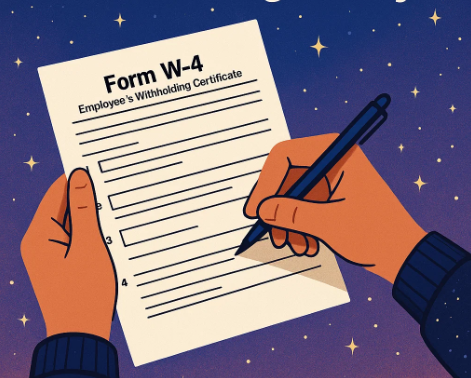Tax Withholding 101: How to Fill Out a W-4 the Right Way
A Simple Guide for First-Time Filers, New Employees, and Anyone Who Wants to Avoid Surprises at Tax Time.
Filling out a W-4 form might seem like just another onboarding form when you start a new job. But it’s actually one of the most important tools for managing your taxes. Done right, it can help you avoid owing a big bill at tax time – or boost your paycheck today.
Whether you’re starting your first job or updating your tax info mid-career, here’s what you need to know about getting your W-4 right.

What is the W-4 Form?
The W-4, officially called the Employee’s withholding certificate, tells your employer how much federal income tax to withhold from your paycheck. That money goes to the IRS throughout the year as a prepayment of your annual tax bill. At tax time, the amount withheld gets reconciled with that you actually owe. If too much was taken out, you get a refund. Too little, and you’ll owe the IRS.
📌 Why It Matters
- If you withhold too little, you might owe taxes and possibly penalties
- If you withhold too much, you get a refund- but that’s money you could have had in your paycheck all year long
The W-4 gives you some flexibility to fine-tune how much tax is withheld based on your situation.
👣 Step-by-Step: How to Fill Out the W-4
Here’s how to approach each section of the W-4, especially if you’re a middle-income earner or first-time filer.
Step 1: Basic Info
Fill in your name, Social Security number, and filing status (single, married filing jointly, etc.)
🔍 Tip: Your filing status affects your withholding rate, so choose carefully.
Step 2: Multiple Jobs or Spouse Work
Check this box if you:
- Have more than one job at a time, or
- Are married and both you and your spouse work
💡 Use the IRS online Tax Withholding Estimator for more accurate results.
Step 3: Claim Dependents
If your income is under $200,000 (single) or $400,000 (married jointly), you can claim:
- $2000 per qualifying child under age 17
- $500 per qualifying dependent (other than children under 17)
Step 4: Other Adjustments (Optional but Useful)
This section is where you can:
- Add other income (like freelance work)
- Include deductions (if you plan to itemize or have significant student loan interest, IRA contributions, etc.)
- Request extra withholding per paycheck to cover gaps
🎯 Tip: If you owed last year, this is a smart place to add a cushion.
Step 5: Sign and Submit
No signature=no valid form. Don’t forget this step!
When Should You Update Your W-4?
You should review and possibly update your W-4 if:
- You get married or divorced
- You have or adopted a child
- You started a second job
- Your spouse changes jobs
- You had a large tax bill or refund last year
🚀 Take Control of Your Paycheck
Filling out the W-4 properly puts you in the driver’s seat of your tax situation. It’s one the easiest ways to make sure you’re not caught off-guard come tax season. Or waiting too long to get back money that’s already yours.